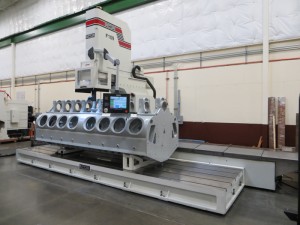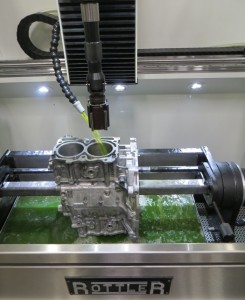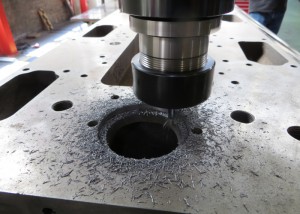 Advancements in engine machining technology have truly moved this industry firmly into the space age. Highly developed abrasives and computer numeric controlled (CNC) software are found at almost every level of equipment, leaving some to mourn the loss of the “art” of engine machining in favor of the “science” of precision.
Advancements in engine machining technology have truly moved this industry firmly into the space age. Highly developed abrasives and computer numeric controlled (CNC) software are found at almost every level of equipment, leaving some to mourn the loss of the “art” of engine machining in favor of the “science” of precision.
Of course, far more say the accuracy and speed available from and with today’s equipment is paramount to a shop’s success in this ever-competitive business. What people are really concerned about is whether continued advancements will mean high tech will only be available with a big check.
“Shop owners who have embraced CNC say the technology allows them to do more work with the same number of employees, or in some cases to trim staff,” explains Rottler Manufacturing’s VP Sales and Marketing Anthony Usher. “Once a job has been set up, the automatic controls take over and do all of the machine work. If it’s a long job, the machine doesn’t stop working at 5 o’clock and go home. Even your best, most dedicated employee won’t be able to work 24 hours straight and maintain the consistency you require. Today’s equipment can mean a huge cost savings in labor for shops.”
Are engine builders and machine shops currently equipped to handle today’s engine building needs?
According to Bob Dolder, Automotive Sales & Applications Manager at Sunnen Products Company, asking if shops can keep up today is a tough question to answer definitively.
“It’s a mixed bag…many engine builders have kept up with the equipment improvements over the years, and they are ready for whatever walks in the door,” Dolder confirms. “But there are a lot of shop owners who have not kept up with technology for whatever reason – perhaps the owners are older and are looking towards retirement – and they are right on the fringe of not being able to do the kind of precision machine work that customer’s today require. The latter group who do not keep up with technology will eventually be out of business whether they want to or not.”
 John Cowher, General Manager and Sales Manager for Centroid Performance Racing, says understanding the definition of “equipped” is critical to answering that question.
John Cowher, General Manager and Sales Manager for Centroid Performance Racing, says understanding the definition of “equipped” is critical to answering that question.
“Of course, some are and some are not. Depends on what the reference is. There are different classes of engines and different classes of engine builders and each are generally equipped to do what they need to do to compete in each arena,” says Cowher.
“You can’t take anything away from a good old boy engine builder – he knows how to make things work whether he has modern equipment or not if he’s keeping up with the demands of what the customer needs. A lot of guys farm jobs out they don’t have equipment for: they find a way to stay in it.”
“Machine shops that are surviving or showing growth have likely invested in new equipment, or have updated their processes to capture the needs of today’s engine building markets,” explains Matt Meyer, manager of RMC Engine Building Equipment. “Many shops have had to focus on more niche markets rather than try to do everything and anything that comes their way, but focusing on what they do best and what is most profitable. We’ve been focusing on these niche market customers that demand a turnkey package of machine, fixtures, tooling and programming to maximize their throughput and resulting profitability.”
Meyer explains, however, that while looking forward is ever-important, one of the largest challenges a shop owner has today is finding a qualified machinist who have sufficient experience to efficiently run the older equipment that lacks the user automation features of the newer equipment.
Manual machines require an operator to literally stand permanently at the machine doing the same thing over and over again – and frankly, not everyone can do this work. “Not only is this an expensive waste of manpower costs but also is fatiguing for operators, especially for production facilities. Machinists become bored and unproductive and do not enjoy their job, producing poor quality and low productivity results,” Usher says.
“Even your best, most skilled operator is a human being, occasionally has a bad day and now and then makes mistakes. Because late model engines have much closer tolerances than engines from a few decades ago, you must be right on when you bore, hone and machine critical components. There’s less room for error, let alone outright mistakes, so once you have a process in place that delivers the accuracy you want, you don’t have to worry about mistakes messing up a job,” Usher explains.
 So today, many shops are making the move from yesterday. And what about tomorrow? Equipment suppliers recognize that opportunities to adapt are still out there.
So today, many shops are making the move from yesterday. And what about tomorrow? Equipment suppliers recognize that opportunities to adapt are still out there.
“Tomorrow’s market is somewhat cloudy,” says RMC’s Meyer. “The uncertainty of the world market trends, new developing energy sources, and engine materials along with changing EPA rules, all will play a part in changing direction of future engine builders. Racing will always be a sector of the machine shop market, satisfying man’s (or woman’s) need for speed and competition. Today, almost anything that has an engine will likely end up in competition of some form or another, be it cars, bikes, trucks, tractors, boats, ATVs, UTVs, aircraft and others.”
Changing needs in the engine shop, in most cases, are being driven by the new vehicle market.
“Sunnen partners with a number of OEM manufacturers and R&D shops working on the development of tomorrow’s engines, and we have a good idea of what is going to hit the market before it happens,” says Dolder. “We have to develop the honing technology necessary to manufacture those engines and in many cases be able to hone the parts back to OEM specs during the rebuilding process. Tomorrow’s engines will be manufactured to tighter tolerances for better efficiency and lower emissions, and in some cases be made of different materials. Engine builders need to be ready to work on them and yesterday’s equipment often will not do the job.”
As in the wild not everyone will be able to keep up.
“Some are ready for tomorrow and some are not,” Cowher explains. “Basically there comes a time when a decision has to be made if you want to continue to stay in business. As it pertains to performance, if shop owners don’t keep up with technology, chances are their competitors are. The competitor will simply eat your lunch and hand you the bag!”
Similar to a close relationship with the OE, the needs of the machine shop owner and operator play a part in meeting tomorrow’s needs. “Customer satisfaction is one of our goals when developing a new machine,” says Rottler’s Usher. “We need to make a machine that’s going to work well for that customer without modifications and without a lot of training. It needs to be user friendly. We want our customers – even if they’re new to the business – to be able to run the machine and do what they need to do. You can’t make money if you’re struggling to learn the machine.”
By observing customers’ operations and asking questions about the issues they’re facing on a day-to-day – or even hour-to-hour – basis, manufacturers are able to develop products that save time, money and inconvenience.
“If one customer tells us that he feels a machine needs to have something changed, our engineers understand that many others may feel the same way,” Usher says. “And many of these suggestions happen in real time. While future designs may incorporate those requests, today’s interconnectivity between our customers and our engineers mean we can often solve their complaints immediately using software updates, eliminating the need to wait for tomorrow.”
Dolder cautions that modern machines can only do so much. “New technology can improve the speed and accuracy of machining processes, but they are only as good as the person running them,” he says. “One person might be able to run several CNC machines concurrently that in the past required two or more dedicated operators, but it still takes a well-trained and educated operator to get the most out of a new machine.”
The new machines coming out today require less mechanical skill to operate, Dolder says, but utilize more computer skills, which today’s youth are comfortable with. “Luckily there are a number of great schools around the country teaching automotive technology, so there isn’t what I would call a shortage if you know where to look.”
Meyer agrees that Gen X, Y and the Millennials are ready to learn the next generation of machines – and he anticipates this trend accelerating.
“If our government moves to increase domestic manufacturing by supporting technical education curriculums in our schools, it will likely produce many trained and interested applicants to help fill the needs of the future engine machine shops,” he says.
And, he offers an alternate solution: “As a former shop owner I would look for a suitable candidate to train into a ‘home grown’ machinist, and offer a competitive wage-benefit package to provide him or her an ongoing future with my company. Acquiring newer automated equipment can somewhat overcome the exchange of a ‘fully qualified and experienced machinist’ for a new hire interested in a career in the automotive machine shop business,” Meyer says.
 Usher points out that modern equipment allows you to more work in-house, improving your shop’s productivity.
Usher points out that modern equipment allows you to more work in-house, improving your shop’s productivity.
Cower concurs that the will to learn continues to be a key requirement. “The new CNC systems we sell are automated and quite interesting and do interesting and magnificent work. They are also challenging and a lot of fun, but where there is will to learn, the equipment is structured as such that it is user friendly. These new CNCs run lights out. They do not call in sick, collect a check, or complain. They will work a double shift and won’t get tired. Will there be new problems? Sure.”
One of those problems of getting new equipment is getting past the perception that you can’t afford it. There are options available to help forward-looking companies get the machines they need.
“At this time most banks and leasing institutions want to lend money to ‘good risk’ prospects, at all-time low interest rates and down payments,” says Meyer. “Many lending institutions are getting very accommodating and creative when it comes to deferred start-up payments. This allows the ROI to get a jump start by using the equipment to generate income to offset the normal start-up cost associated with new equipment.”
Cowher, too, says there are plenty of lending institutions offering purchase to own and lease deals. “I see a mix of shops self-financing, or financed by their local bank or lending institution they have worked with over the years. They should follow up on all the information and referrals while shopping to get a good understanding and comparison before they just plunge into it. They should always be aware of any tax benefits or incentives under Section 179 IRS or otherwise. Sometimes the tax benefits can make or break the decision to purchase.”
Dolder agrees. “There are plenty of leasing companies which will work with small shops with creative financing plans to help upgrade their equipment…just look in the phone book or ask your banker. Recently, I have seen more shops set up LLCs which purchase the equipment and then lease it back to the shop, providing excellent tax advantages. This is best done with the help of your CPA or attorney.”
While CNC machines are often considered a very expensive addition to many shops, financing options, as well as additional productivity, can provide a relatively quick payback.
“Your return on investment will depend on what kind of work you are doing, how many jobs per day, week or month you are doing, how much you are charging for your work, the time and labor savings you realize from automating processes, and any additional savings that result from better quality control (fewer comebacks and do-overs that cost you money),” Usher says. “Frankly, the better question is not “Can you afford it?” but “How can you not afford it?”














